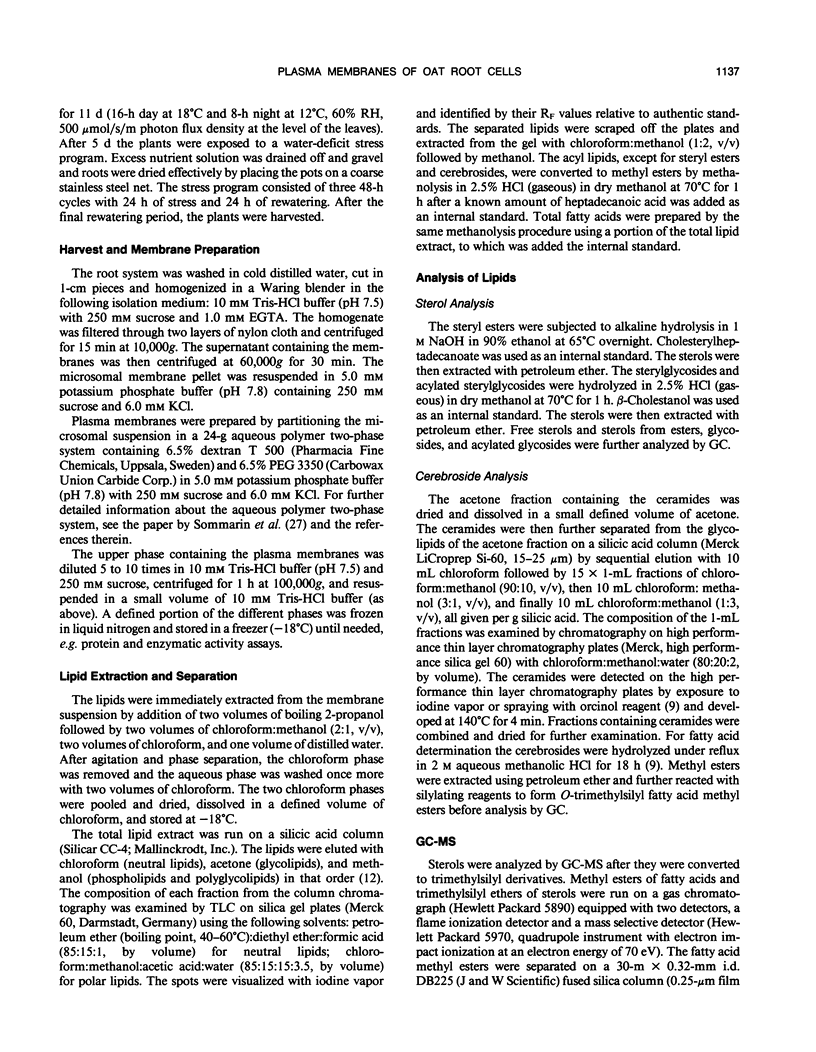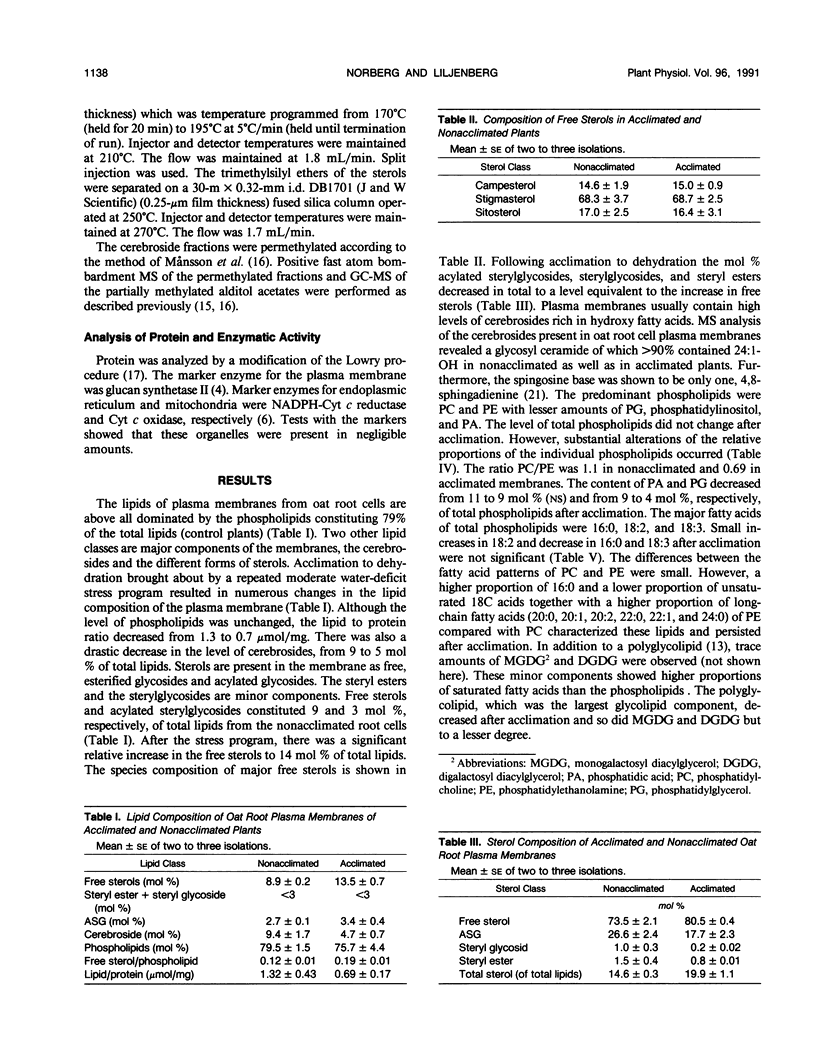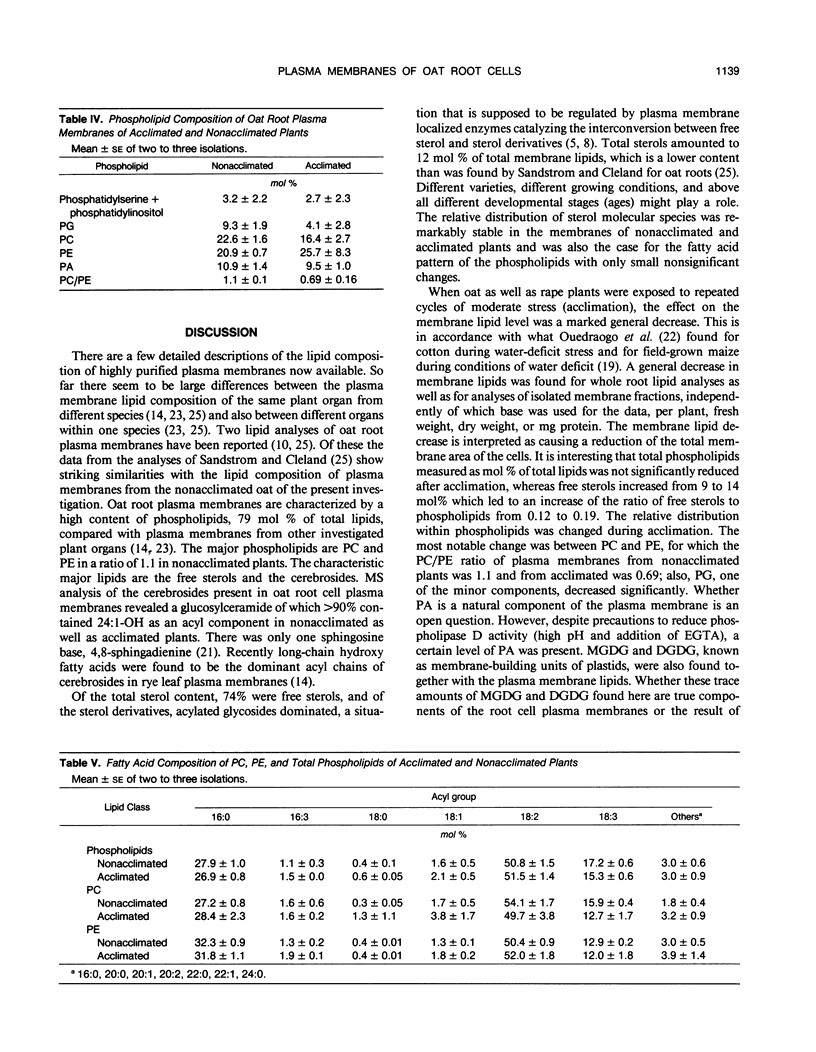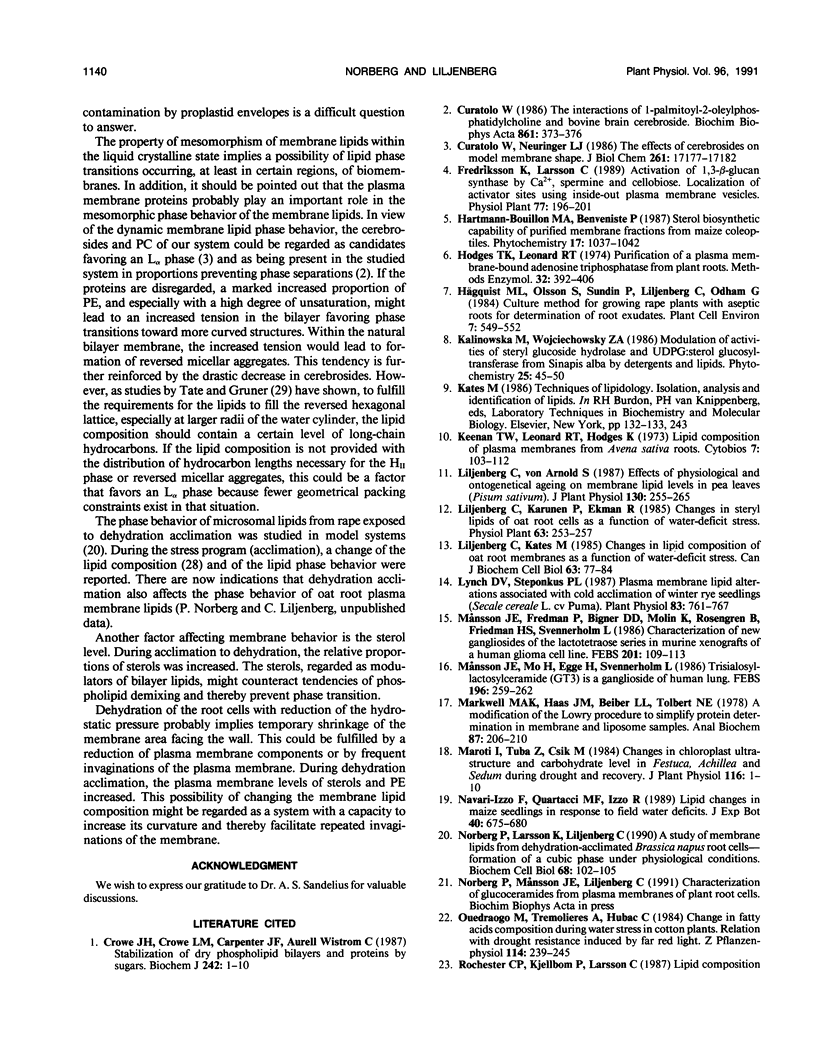Abstract
Plasma membranes were isolated from oat (Avena sativa) roots by the phase-partitioning method. The membranes were exposed to repeated periods of moderate water-deficit stress, and a water-deficit tolerance was induced (acclimated plants). The plasma membranes of the controls (nonacclimated plants) were characterized by a high phospholipid content, 79% of total lipids, cerebrosides (9%) containing hydroxy fatty acids (>90% 24:1-OH) and free sterols, acylated sterylglucosides, sterylglucosides, and steryl esters, together amounting to 12%. Major phospholipids were phosphatidylcholine and phosphatidylethanolamine with lesser amounts of phosphatidylglycerol, phosphatidylinositol, and phosphatidic acid. After the membranes were acclimated to dehydration, the lipid to protein ratio decreased from 1.3 to 0.7 micromoles per milligram. Furthermore, the cerebrosides decreased to 5% and free sterols increased from 9% (nonacclimated plants) to 14%. Because the total phospholipids did not change significantly, the free sterol to phospholipid ratio increased from 0.12 to 0.19. There was no change in the relative distribution of sterols after acclimation. The ratio of phosphatidylcholine to phosphatidylethanolamine changed from 1.1 in the nonacclimated plants to 0.69 in the acclimated plants. The results show that acclimation to dehydration implies substantial alterations in the lipid composition of the plasma membrane.
Full text
PDF





Selected References
These references are in PubMed. This may not be the complete list of references from this article.
- Crowe J. H., Crowe L. M., Carpenter J. F., Aurell Wistrom C. Stabilization of dry phospholipid bilayers and proteins by sugars. Biochem J. 1987 Feb 15;242(1):1–10. doi: 10.1042/bj2420001. [DOI] [PMC free article] [PubMed] [Google Scholar]
- Curatolo W., Neuringer L. J. The effects of cerebrosides on model membrane shape. J Biol Chem. 1986 Dec 25;261(36):17177–17182. [PubMed] [Google Scholar]
- Curatolo W. The interactions of 1-palmitoyl-2-oleylphosphatidylcholine and bovine brain cerebroside. Biochim Biophys Acta. 1986 Oct 9;861(2):373–376. doi: 10.1016/0005-2736(86)90441-4. [DOI] [PubMed] [Google Scholar]
- Hodges T. K., Leonard R. T. Purification of a plasma membrane-bound adenosine triphosphatase from plant roots. Methods Enzymol. 1974;32:392–406. doi: 10.1016/0076-6879(74)32039-3. [DOI] [PubMed] [Google Scholar]
- Lynch D. V., Steponkus P. L. Plasma Membrane Lipid Alterations Associated with Cold Acclimation of Winter Rye Seedlings (Secale cereale L. cv Puma). Plant Physiol. 1987 Apr;83(4):761–767. doi: 10.1104/pp.83.4.761. [DOI] [PMC free article] [PubMed] [Google Scholar]
- Markwell M. A., Haas S. M., Bieber L. L., Tolbert N. E. A modification of the Lowry procedure to simplify protein determination in membrane and lipoprotein samples. Anal Biochem. 1978 Jun 15;87(1):206–210. doi: 10.1016/0003-2697(78)90586-9. [DOI] [PubMed] [Google Scholar]
- Månsson J. E., Fredman P., Bigner D. D., Molin K., Rosengren B., Friedman H. S., Svennerholm L. Characterization of new gangliosides of the lactotetraose series in murine xenografts of a human glioma cell line. FEBS Lett. 1986 May 26;201(1):109–113. doi: 10.1016/0014-5793(86)80580-4. [DOI] [PubMed] [Google Scholar]
- Månsson J. E., Mo H. Q., Egge H., Svennerholm L. Trisialosyllactosylceramide (GT3) is a ganglioside of human lung. FEBS Lett. 1986 Feb 17;196(2):259–262. doi: 10.1016/0014-5793(86)80259-9. [DOI] [PubMed] [Google Scholar]
- Rochester C. P., Kjellbom P., Andersson B., Larsson C. Lipid composition of plasma membranes isolated from light-grown barley (Hordeum vulgare) leaves: identification of cerebroside as a major component. Arch Biochem Biophys. 1987 Jun;255(2):385–391. doi: 10.1016/0003-9861(87)90406-1. [DOI] [PubMed] [Google Scholar]
- Sandstrom R. P., Cleland R. E. Comparison of the lipid composition of oat root and coleoptile plasma membranes: lack of short-term change in response to auxin. Plant Physiol. 1989;90:1207–1213. doi: 10.1104/pp.90.3.1207. [DOI] [PMC free article] [PubMed] [Google Scholar]
- Senaratna T., McKersie B. D., Stinson R. H. Association between Membrane Phase Properties and Dehydration Injury in Soybean Axes. Plant Physiol. 1984 Nov;76(3):759–762. doi: 10.1104/pp.76.3.759. [DOI] [PMC free article] [PubMed] [Google Scholar]
- Tate M. W., Gruner S. M. Lipid polymorphism of mixtures of dioleoylphosphatidylethanolamine and saturated and monounsaturated phosphatidylcholines of various chain lengths. Biochemistry. 1987 Jan 13;26(1):231–236. doi: 10.1021/bi00375a031. [DOI] [PubMed] [Google Scholar]
- Whitman C. E., Travis R. L. Phospholipid composition of a plasma membrane-enriched fraction from developing soybean roots. Plant Physiol. 1985 Oct;79(2):494–498. doi: 10.1104/pp.79.2.494. [DOI] [PMC free article] [PubMed] [Google Scholar]
- Yoshida S., Uemura M. Protein and Lipid Compositions of Isolated Plasma Membranes from Orchard Grass (Dactylis glomerata L.) and Changes during Cold Acclimation. Plant Physiol. 1984 May;75(1):31–37. doi: 10.1104/pp.75.1.31. [DOI] [PMC free article] [PubMed] [Google Scholar]


